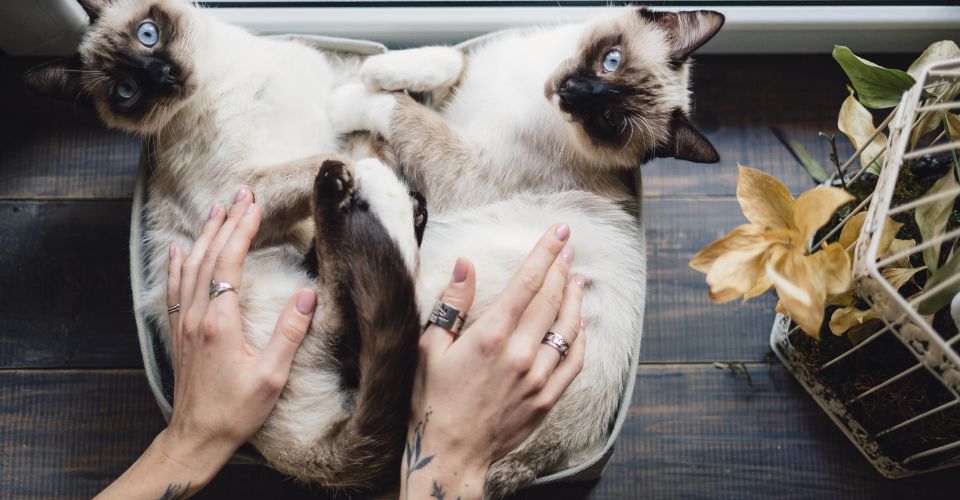How Do Cats Get Cats have one of the most sparkling eyes among animals, but when they’re blue, they’re even more attractive. A surprising fact about kittens is that all of them are born with blue eyes. Still, it is very uncommon to have cats with blue eyes once they grow into adults.
If you are looking to adopt a cat breed with blue eyes, continue reading as we are going to discuss all about blue-eyed cats.
Blue Eyes?
Cats’ eyes have a special pigment called melanin that is produced by melanocytes. These specialized cells are present in the iris as well as the cat’s skin. The eye color of cats’ eyes is determined by the density of melanocytes in the front layer of the iris. Cats have blue eyes when there are lesser numbers of melanocytes. This allows short light wavelengths such as blue to pass and reflect and absorb the longer light wavelengths, such as red ad yellow.
This means that there is no blue pigment that imparts blue eye color in cats’ eyes. Instead, the lack of pigment creates an interesting absorbing/reflecting phenomenon, making cats with lesser melanocytes appear blue.
This is the reason that when kittens open their eyes, they have a blue color. Melanocytes do not start accumulating in the kittens’ eyes until they are about 6 to 8 weeks old. If the kitten is not going to have blue eye color, it would first develop yellow color, and by the age of 12 weeks, it would have developed her adult eye color.
Cat Breeds With Blue Eyes
Mostly cats’ eyes have either shades of yellow or green. Blue eyes are a bit rare. Cats with recessive white or color-point genes are more likely to have blue eyes.
Here is a list of 11 cat breeds that always or sometimes remain blue-eyed even when after growing up.
1. Birman

Breed Overview
Weight: 6 – 15 pounds
Lifespan: 15 – 20 years
Coat Color: Various colors, including blue, seal, lilac, cream, and red. Like all point cats, they are born all white and later develop colors
Temperament: Friendly, sociable, curious, laid-back
Suitable for: Multi-pet households, families with children
Birman, also called the “Sacred Cat of Burma,” is a semi-longhaired cat with dark coloring on its face, legs, ears, and tails. The name of the breed is derived from the word Birmanie, the French form of Burma. The cat has short legs and a thick body with white mittens on its paws. The breed is playful, sweet, and friendly and has attractive blue eyes. They easily get along with dogs and are thus considered one of the dog-friendly cat breeds, making a perfect choice for people having a dog living under their roof.
Birman cats always have blue eyes. Deeper and more vivid the blue color, the better. The ideal Briman eye color is sapphire blue.
2. Balinese

Breed Overview
Weight: 8 – 15 pounds
Lifespan: 8 – 13 years
Coat Color: A rainbow of colors including white, red, gray, blue, orange, beige
Temperament: Devoted, affectionate, independent
Suitable for: People with allergies, outgoing cat parents
Balinese cats always have deep, vivid blue eyes. And the deeper and more vivid the color, the better.
They are outgoing, curious, and attractive cats. The breed is famous for its interactive personality and is not for someone who wants their cat not to be heard. The cat is loveable, intelligent, and can prove to be a perfect friend. Balinese cats have large ears and are thus categorized as a cat breed with big ears.
Balinese cats shed very little, which has earned them a reputation as a hypoallergenic cat breed. They are one of the most loyal and affectionate cats of the feline world, and given that they are less prone to trigger allergic reactions in their owners, they make a perfect choice for people with allergies.
3. Himalayan
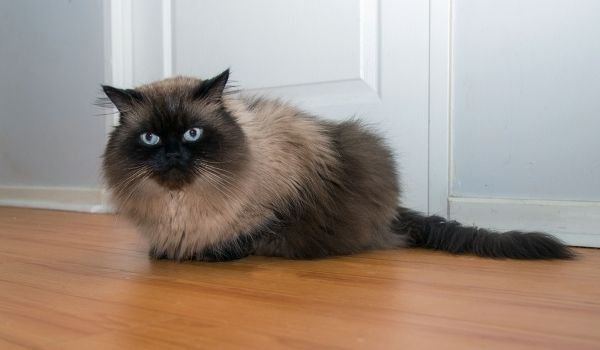
Breed Overview
Weight: 7 – 12 pounds
Lifespan: 9 – 15 years
Coat Color: Wide range of colors including white, seal, blue, flame, cream, lilac
Temperament: Laid-back, intelligent, and playful
Suitable for: Multi-pet households, families with children
The Himalayan cat is an identical Persian cat breed but has a few distinguishing features like facial masks, feet, tails, and ears. They are medium-sized cats but sometimes can appear bigger due to the additional mass of fur. The cat is also referred to as ‘Himalayan Cat’ or ‘Colorpoint Persian’ for being created by crossbreeding Siamese cats and Persian cats. Like Persian cats, they also have flat faces and thus are listed as one of the flat face cat breeds.
The Himalayan cats’ eyes are always blue and vivid and come in various shades and densities. The cat is incredibly playful and friendly, but it can create mischief if not given the right amount of care and enrichment. It needs high maintenance.
4. Ragdoll
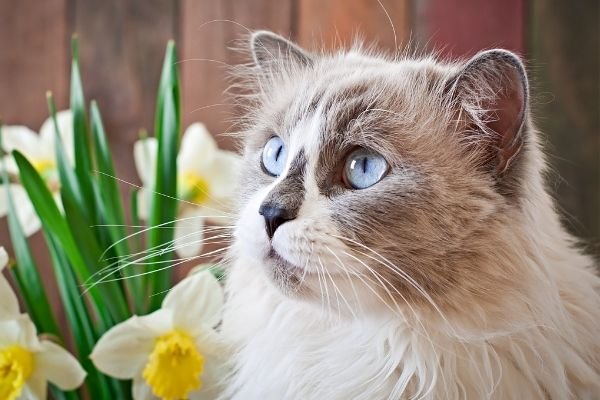
Breed Overview
Weight: 10 – 20 pounds
Lifespan: 13 – 18 years
Coat Color: Various colors, including white, black, blue, gray, lavender
Temperament: Super affectionate, bold, sociable, docile
Suitable for: Families with children, multi-pet households, people with allergies
The name “Ragdoll” means the tendency of individuals to relax when picked up. This breed was developed by American breeder Ann Baker in the 1960s and is best known for its friendly and affectionate nature. Ragdoll cat tends to be more interested in human beings than other cat breeds and therefore are also known as “dog-like cats” or “puppy-like cats.” They would run to greet you at the door, follow you from room to room, and generally choose a place for themselves where you are.
Ragdoll cats have long-haired coats and are thus categorized as fluffy cats. Despite their fluffy coats, Ragdoll cats shed very little and produce very little quantity of Fel D1 allergen. To know more about their hypoallergenic status, check out Are Ragdoll Cats Hypoallergenic?
5. Siamese
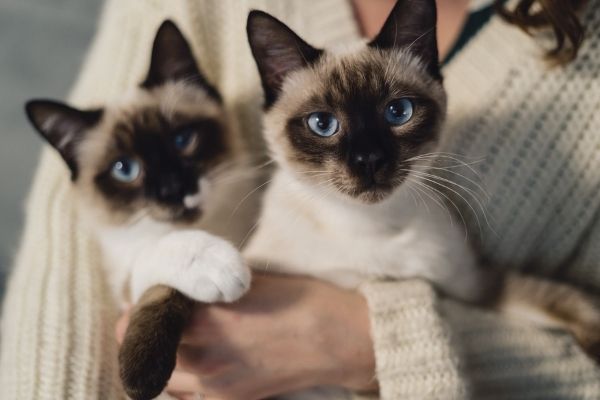
Breed Overview
Weight: 6 – 14 pounds
Lifespan: 15 – 20 years
Coat Color: Varying colors including white, chocolate, sable, ebony, black
Temperament: Highly sociable, bold, neurotic, outgoing
Suitable for: Multi-pet households, families with children, outgoing cat parents
One of the most distinctively recognized breeds of cats with blue eyes is Siamese. Siamese cats have different color variations, such as Flame Point Siamese, Blue Point Siamese, Lynx Point Siamese, etc. They are best known for their distinctive sleek appearance and color points. Irrespective of the colorpoint variation, Siamese cats always have deep vivid blue eyes.
This cat originated in Thailand around the 14th century and is believed to be one of the oldest breeds of cats alive. Siamese cats have received royal treatment in Thailand as royal families believed that a Siamese cat would receive their souls when they die. Siamese cats have a history of being in the white house as US President Rutherford personally kept one during his tenure. This breed is extremely talkative and will vocalize its opinion on any observation they make while sitting in its window perch.
Siamese cats make great pets for outgoing cat parents as they are high-energy and love to go on long walks. They shed very little compared to other cat breeds and thus easily find a spot on the list of cat breeds that don’t shed.
White Cats With Blue Eyes
6. Persian
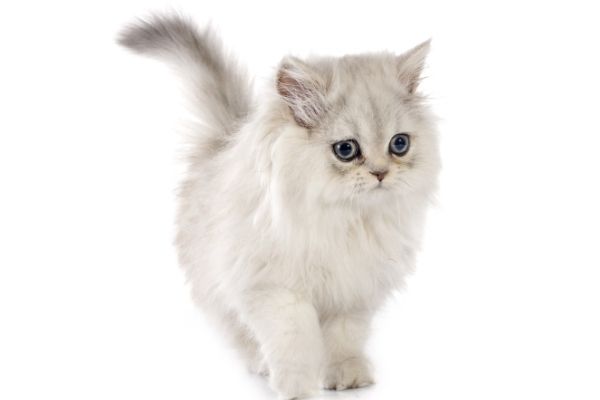
Breed Overview
Weight: 7 to 12 pounds
Lifespan: 15 to 20 years
Coat Color: A variety of colors divided into seven divisions: solid, golden, smoke and shaded, tabby, parti-color, and bicolor and Himalayan division
Temperament: Sociable, affectionate, calm, and sweet
Suitable for: Families with a calm and quiet household, calm and lazy parents
Persian cats either have deep blue or copper eye color. They are often odd-eyed, with one eye blue and the other copper.
The Persian cat is a long-haired breed of Iranian origin, characterized by its silky soft coat, punch face, and loveable personality. They are also known as “Persian longhairs” in English-speaking countries. White Persian cats are one of the world’s most popular and recognizable pet breeds. They are calm, loving, and like nothing other than just sitting in their owner’s lap—how adorable!
They come in a variety of colors that are divided into seven categories. In solid colors, they not only come in white but also in solid brown colors and are thus listed as a brown cat breed. Because of their easy-going temperament, Persian cats make great family pets. But if you are going to get one for your home, you should keep in mind that they are a flat-face cat breed. And this flat face makes them prone to feline upper respiratory infection.
7. Snowshoe
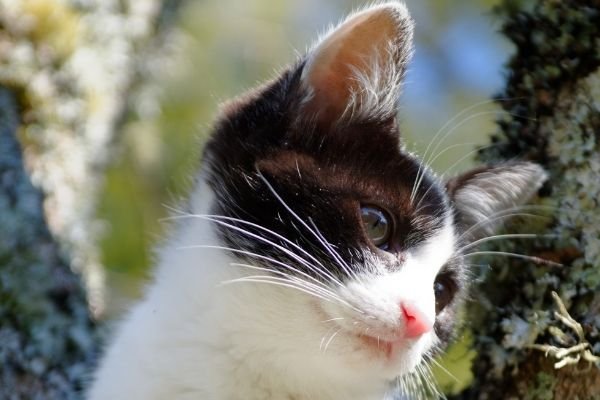
Breed Overview
Weight: 7 to 14 pounds
Lifespan: 14 to 20 years
Coat Color: Many colors, including beige, tan, brown, sable, white, blue, gray
Temperament: Playful, affectionate, anxious when left alone
Suitable for: Families with children, multi-pet households
The snowshoe is a smart and vocal breed of cat which originated in the United States during the early 1960s. The breed was created by Dorothy Daugherty, an American breeder who crossbred Siamese cats with American shorthairs. The cat gets its name from its white mitten paws that look like they are being dipped in the snow.
Blue eyes are one of the signature features of these cats and can come in a range of blues, such as pale sky blue, azure, and light blue. This pet is perfect for parents who are ready to adopt a pet and love her like a child. They would develop separation anxiety if left alone for a long time. Therefore, you should get them a canine or feline friend if you have a traditional 9 am to 5 pm job. You can also teach Snowshoe cats how to walk on a leash.
8. Turkish Angora
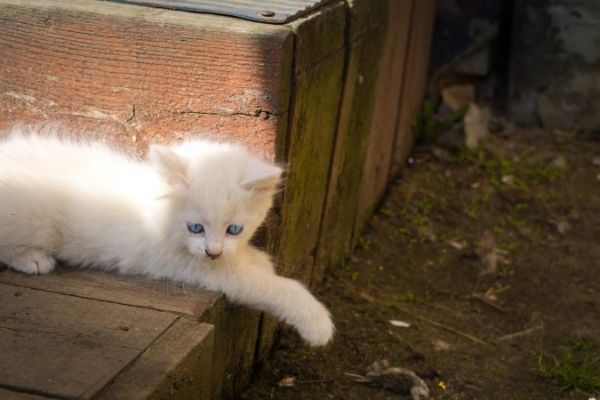
Breed Overview
Weight: 5 to 10 pounds
Lifespan: 13 to 20 years
Coat Color: Variety of colors including solid black, white, and cream; in tortoiseshell; in classic, mackerel and spotted tabbies of many colors; and bi-color
Temperament: Highly sociable, highly adaptable
Suitable for: Families with children, families with other pets, active cat parents
Turkish Angora is one of the rare cat breeds of the feline world. Their fluffy white coat, exquisite blue eyes, and swimming prowess make them one of the most popular and sought-after cat breeds. It is one of the ancient and naturally occurring breeds of cats. This breed is often referred to as Angora or Ankara cat for its origin in Turkey.
Turkish cats come in a wide range of eye colors. The acceptable colors are blue (sky blue to sapphire), green (gooseberry to emerald), and amber (gold-rich to copper). They are often odd-eyed, with one eye blue and the other green, green-gold, or amber.
In addition to their most famous glistening white coat, they also come in calico coats. They are sociable and are best suited for a home where there is another cat or dog in the company. Angoras bond completely with their owner. During the day, you’ll find her across your shoulders, while you’ll find her next to your pillow at night. Where most cats hate water, Turkish Angoras love playing with water.
Legend says that Prophet Mohammad (570 – 632 CE), the prophet of Islam, was so fond of cats that he once cut off his sleeve rather than disturb the sleep of his cherished Angora, Muezza.
9. Tonkinese
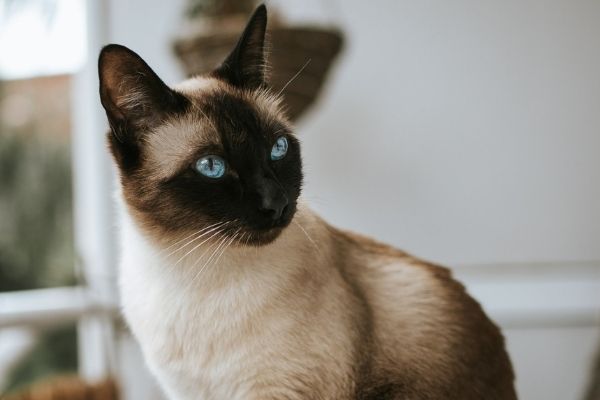
Breed Overview
Weight: 6 – 12 pounds
Lifespan: 15 – 20 years
Coat Color: 12 color and pattern varieties
Temperament: Super affectionate, curious, bossy, attention-seekers
Suitable for: Multi-pet households, families with children
Tonkinese is a breed of cat produced by crossbreeding Siamese and Burmese breeds. The first debated crosses were conducted by Milan Greer, who named these cats “golden Siamese.” Tonkinese cats are famous for their highly affectionate and sociable. They come in solid, point, and mink patterns. Point Tonkinese have blue eyes, mink Tonkinese have aqua-hued eyes, and solid Tonkinese has green/yellow eyes.
Though not as chatty as the Siamese, Tonkinese cats express their feelings and love towards their loving owners by curling up in their warm laps or sometimes lying on top of the chest of their rowers. They make a great loveable pet, but you should know that they are a bit of attention seekers and don’t rest until they get it—when they want to hop up in your lap, you cannot refuse them.
10. Ojos Azules
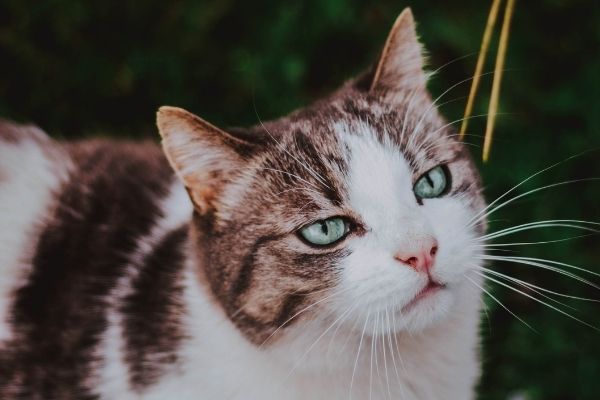
Breed Overview
Weight: 9-12 pounds
Lifespan: 10-12 years
Coat Color: Many colors and patterns but are never solid whites
Temperament: Intelligent, playful, affectionate
Suitable for: Families, outgoing cat parents
Out of all the types of black cat breeds, the only widely known cat breed is Ojos Azules. The Ojos Azules (the Spanish translation of “blue eyes”) is a fitting name for a cat breed because of its beautiful blue eyes. Despite not having a solid white or pointed color pattern, Ojos Azules cats always have unusually deep blue eyes.
The first breed of the cat dates back to 1984 when a female tortoiseshell cat named Cornflower from a feral colony in New Mexico gave birth to a litter of kittens. Those kittens featured the same intense blue eyes as their mother, thereby proving that this was a dominant trait in this breed. The depth of their eyes is even greater than seen in the Siamese breed. The blue eyes seen in Ojos Azules are due to the absence of melanin in the iris, while the depth of color is due to polygenetic variations.
Things to Know About Blue-Eyed Cats
Are Blue-Eyed Cats Deaf?
Not all blue-eyed cats are deaf. But yes, the incidence of deafness is high in blue-eyed cats with white color coats.
Where 17% to 22% of the white cats with non-blue eyes are deaf, and 40% of the white cats with one blue eye are born deaf. And around 65% to 85% of white cats with both eyes blue are deaf, according to Cornell Feline Health Center.
If your odd-eyed (with one blue eye) cat is deaf, she will probably be deaf in the same ear as the blue eye. How Can You Tell if Your Blue-Eyed Cat Is Deaf?
If you just adopted or rescued a white cat with blues, you must be concerned if she is deaf. Here is how you can check if your cat is deaf or not:
- Stand several feet behind your cat and clap.
- If your cat reacts or looks back, she is probably not deaf—at least not in both ears.
- Cats can also feel non-auditory vibrations, so to confirm if your cat is deaf or not, you can take her to a veterinarian for definitive testing.
Cats with blue eyes are hard not to fall in love with but have you ever looked into the eyes of cat breeds with big eyes?
11. Javanese
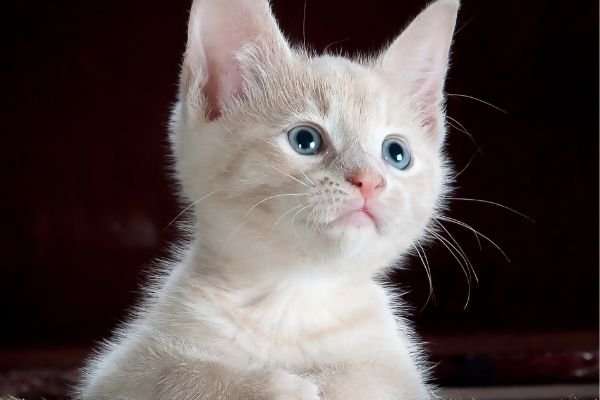
Breed Overview
Weight: 8 – 15 pounds
Lifespan: 12 – 15 years
Coat Color: Lynx point, tortie point, red/cream point
Temperament: Less demanding, intelligent, sociable
Suitable for: Active cat parents, multi-pet households
The Javanese is a blue-eyed cat breed that was developed by crossbreeding Siamese and Balinese breeds. They always have a deep vivid blue eye color. Eye color other than blue leads to disqualification, according to CFA standards.
They are muscular cats who love to jump and climb. They are very intelligent and can learn different tricks quickly. They love to follow the commands of their favorite human—you. You can easily use cat clicker training to teach your cat various tricks and commands.
The cat appears elegant and delicate due to its blue eyes and is well known for its effective communication skills. They have big ears compared to many other cat breeds and are thus listed as a cat breed with big ears.



